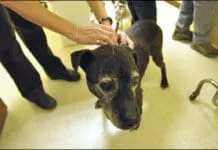Home Search
raw%20dog%20food - search results
If you're not happy with the results, please do another search
Managing Your Dog’s Stress – A Holistic Approach
says Dr. Paul McCutcheon.üAfter taking a blood sample for lab testing, a holistic veterinarian uses acupuncture the best of East and West.
Dancing With Dogs
Snapping fingers and tapping feet are the signature moves of musical freestyle – and that’s the audience! What happens between dog and handler during a musical freestyle performance is simply magical. The handler gives subtle cues, and her dog executes complicated maneuvers, one after the other, as the pair moves across the floor, their routine choreographed to music that emphasizes their connection. For those of you whose introduction to this sport was watching a widely distributed video clip of Carolyn Scott’s routine to “Grease” with her Golden Retriever, Rookie, you were probably awestruck. You may have even gotten a little misty eyed, recognizing the commitment, training, and connection between two different species. But it was the look on Rookie’s face that sold you that this was a sport worth exploring. This dog was having a blast, and the behaviors he was doing were difficult! How could training something so hard be so fun?
How Whole Dog Journal Helps
Please remember to mention rescue groups for people looking for specific breeds. We love Newfoundlands, and are celebrating the one-year anniversary of our adoption...
Selecting The Best Family Dog and Preparing Him for Children
not just tolerate them. And if she shows signs of discomfort (such as looking away or moving away from children)
Hemorrhagic Gastroenteritis in Dogs
The symptoms came on fast and furious. One day Chloe was a healthy, tail-wagging Labrador Retriever and the next day she was vomiting mucus all over the house. Then her vomit turned red with blood and then came matching diarrhea. Chloe had hemorrhagic gastroenteritis, or HGE. Hemorrhagic gastroenteritis is a mystery disease. No one knows what causes it and there is no recommended prevention. It does not seem to be contagious from one dog to another, although dogs living together sometimes develop HGE at the same time, and some parts of the country have reported outbreaks of several cases. It's most dangerous for small dogs, and although some veterinarians consider toy and miniature breeds between the ages of two and four the most typical HGE patients, males and females of all breeds and ages have been affected. There are few, if any, HGE warning signs. It is not usually accompanied by a fever. Diarrhea containing bright or dark red blood is the illness's signature symptom. Vomiting, which usually accompanies the diarrhea, typically begins as mucus or bile and then becomes bloody. Affected dogs may eat grass and vomit that as well.
Probiotics and Dogs
Curly, a five-year-old Standard Poodle, eats the best food his human can afford. Raw chicken, rabbit, and venison are his favorites. Tina, his two-legged companion, switches the meats every few days, mixing the protein with some sweet potato, carrots, an occasional stalk of broccoli, and always a good fish oil supplement. Plus, to be sure that Curly is getting full nutritional benefit from every delicious bite, Tina always adds a sprinkling of a probiotic and digestive enzyme supplement as a final touch. Everything Curly eats is the best of the best: human-grade ingredients, no preservatives, no by-products. But somehow, despite all of the good lovin' and great food, Curly is a bit thin, won't put on weight, and his stool is sometimes dry making it hard for the poor guy to poop during his daily walks. Tina knows that something is amiss and she is worried. She was told that maybe the probiotics weren't active, so she tried several different brands. But nothing has improved. So what gives; is it that the probiotics don't work? Adding supplemental Lactobacillus acidophilus, Bifidobacterium bifidum, Lactobacillus bulgaricus, or other probiotic organisms to your dog's diet is almost always a good idea. This will support the resident microflora that are always present in Curly's gut, enhancing digestion and absorption of nutrients, supporting detoxification and elimination processes, and helping to boost his immune system.
High-Energy Canine Competitions
Woof, yap, scream, yodel, bark, yip. Go, go, go!” Dogs on the sidelines and in crates and exercise pens barking at the top of their lungs. Dogs tugging and growling, tugging and growling. Handlers yelling over the din to their teammates. Handlers recalling their dogs over jumps, H-e-r-e! Event officials blowing whistles and announcing the next race over bullhorns or speaker systems, and start-line lights and passing lights flashing on and off. Flyball is a cacophony of sights and sounds. It is exhilarating, over the top, adrenalized hyperstimulation. This is not a sport for the introverted, timid, or sound-sensitive dog or handler. The adrenalin level is off the charts and you can hear that from hundreds of yards away. The first time I experienced flyball was as a spectator at an obedience trial held at a park. Suddenly, shattering the decorum, was an ear-piercing scream followed by rabid barking. Certain that an obedience dog had left the ring and treed a critter, I raced over to watch. No critter. No mayhem. Just flyball. The teams had just set up for their first race and the dogs were ready. I had never seen dogs so keen to get going.
How to Stop Your Dog From Chewing All of Your Shoes
For almost any challenging dog event there are at least five relatively easy things you can do to defuse the crisis and reduce the likelihood of a return engagement of the unwanted behavior. Action Plan" is a new column that will offer five simple solutions for one common undesirable dog behavior. Feel free to suggest your favorites!"
Train Your Dog to Behave During Grooming
Two months ago, I read a news story about a dog owner in Minnesota who had shared her home and her life with her 10-year-old Great Pyrenees for eight years. On December 30, 2008, the dog attacked his owner as she was trying to trim his nails, sending her to the hospital for multiple bite wounds to her arms. The news report on the incident stated, “[The dog owner] was able to reach another room and closed the door, keeping the dog out.” The owner in this sad story was treated and released from the hospital the same day. The dog is now dead – euthanized at the veterinary hospital for safety reasons, at the owner’s request.Nail-trimming should not be a matter of life and death. Nor should any other routine grooming procedure. If a dog objects strongly to any sort of physical contact or restraint that may occur in the process of ordinary care, a smart, responsible owner needs to take immediate steps to overcome his objections in a positive, nonaversive manner. Fortunately, this process (described in detail below) is not difficult (or dangerous!) to do – but it does take a serious commitment of time.
Your Children Should Help Train the Dog
Unless you've been living in a cave for the past year, you know that Malia and Sasha Obama will soon be getting their very first dog. Every year, children all over the world experience the joy of holding a dog or puppy in their arms for the very first time. We trust that the Obamas will select wisely, and make the right training choices for the newest member of the First Family. If a new dog is in your future, we hope that you'll do the same.For many kids, getting a family dog is one of the happiest experiences imaginable. However, disturbing dog bite statistics from the Centers for Disease Control (CDC) suggest that all is not well in the kid-dog kingdom. According to the CDC, each year, 800,000 Americans seek medical attention for dog bites. Half of these are children. Your best insurance against your family being part of these statistics is a puppy-raising program that incorporates proper management and supervision and tons of carefully orchestrated, positive social experiences for your new dog. (For more about how to carry out an ideal socialization program, see The Social Scene














